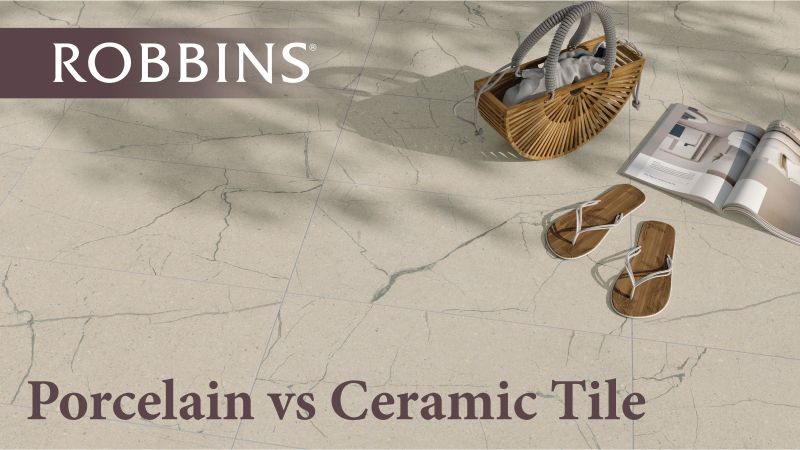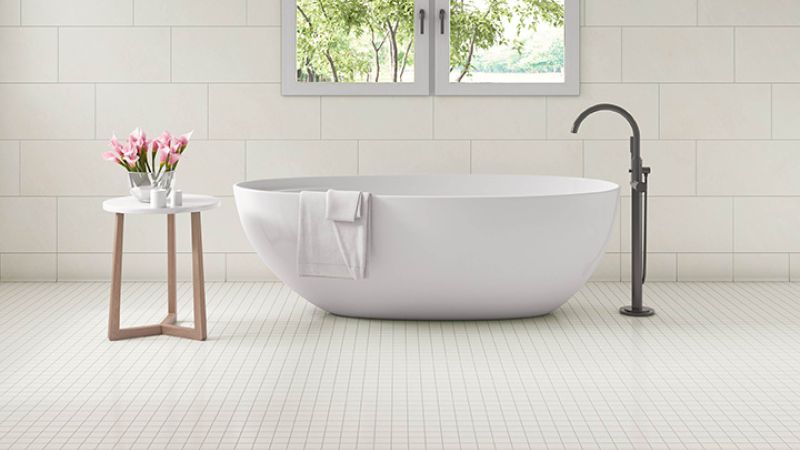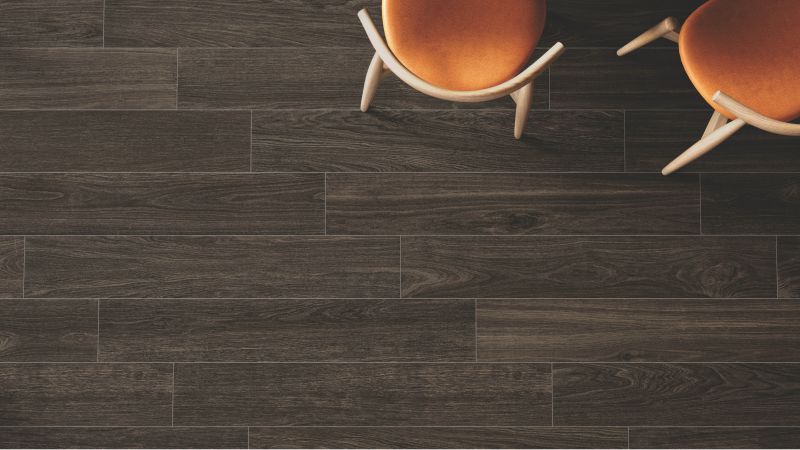Porcelain vs Ceramic Tile – 5 Factors to Help You Decide
Porcelain and ceramic tile flooring are two great options. If you’re like most consumers, you’ll spend hours trying to determine which one is better. And rest assured, you’ll find countless opinions declaring a winner.
But know this – neither porcelain nor ceramic tile is inherently “better.” Indeed, often they’re designated as porcelain and non-porcelain, giving you some notion of their similarity. However, they’re made from slightly different materials and serve various purposes. So, try changing your approach and ask yourself which is better for your needs.

Ask Yourself These Questions to Help Decide
Choosing between porcelain and ceramic isn’t just about price or looks; it’s about understanding where each type works best.
- Do you need something rugged for busy entryways?
- Maybe you want tile that is easy to install on a backsplash.
- Or perhaps you need something that withstands the wet conditions in a bathroom.
This approach lets you select a product that’s a winner for your specific needs. For example, porcelain tile shines for durability and water resistance. Although less durable, ceramic is easier to install because it’s easier to cut than porcelain.
We’ll help you go through the exercise and review five essential factors to help you confidently pick the right tile for your floors, walls, or next project.
A Market Perspective on Porcelain and Ceramic Tile
Before we review the five factors, we can start by declaring that porcelain tile
has become more prevalent in homes. For example, porcelain tile accounted for 56.7% of the North American market share. That stems largely from its durability and water resistance, notably for flooring. However, while porcelain tiles are frequently used and popular for kitchen backsplashes and decorative wall features, ceramic tile also remains popular in these applications.
If you’re a numbers person, that data could be your most critical factor in choosing whether to go with porcelain or ceramic. But let’s dig into other factors and more numbers to help you decide what’s best for you.
This chart will give you some essential insights before we address the factors in greater depth.
| Feature | Porcelain Tile | Ceramic Tile |
| Manufacturing | Denser clay, higher temperatures, finer finish | Less refined clay, lower firing temps |
| Durability | Excellent for heavy foot traffic | Best for low-to-medium traffic |
| Water Resistance | Highly water resistant (<0.5% absorption) | More porous (3–7% absorption) |
| Installation | Needs Pro Tools, more difficult DIY | A little easier to cut for DIY installation |
| Cost | $3–$10/sq ft + higher install cost | $1–$5/sq ft + lower install cost |
| Best Use | Outdoors, wet rooms, busy floors, and walls | Indoors, backsplashes, decorative walls |
| Maintenance | Sweeping or vacuuming, light mopping | Same care, but the glaze may chip over time |
1. Construction Differences: More Heat Means More Strength
Both porcelain and ceramic tiles start as clay mixed with minerals, shaped, and then fired in a kiln. But the firing process sets them apart.
- Porcelain tile fires at higher temperatures (over 1200°C) and under more pressure, creating a denser, more refined product.
- Ceramic tile uses less refined clay fired at slightly lower temperatures (around 1000–1100°C). It often has a glaze coating over a reddish or brownish body.
You’ll notice porcelain feels heavier and less porous, while ceramics have a more porous body underneath their glaze.
Tip: You can easily determine whether a tile is porcelain or ceramic by checking the edge or back of the tile. Porcelain tile flooring usually has a consistent color throughout. Conversely, ceramic tiles contrast the surface glaze and the base.
2. Durability: Handling Heavy Foot Traffic
So now you know the manufacturing process makes porcelain tile harder. But how much harder and what does that translate to?
Porcelain is denser, normally has a higher breaking strength, and is more durable to environmental conditions, especially in a floor application. It is important to check with the manufacturer to make sure the product you are using is recommended by the manufacturer for the type of application you intend to use it in.
Translated into real-world terms, here’s what it means to you. If you expect heavy foot traffic, porcelain tile is the winning solution, especially for flooring. Ceramic flooring will be less capable of handling much wear and tear.

3. Water Resistance: Best for Wet Areas
One major factor in choosing porcelain vs ceramic tile is how well they handle water.
According to ASTM (American Society for Testing and Materials) standards, porcelain is impervious to water. It absorbs less than 0.5% water, making it an excellent choice for bathrooms, kitchens, laundry rooms, and outdoor patios.
Conversely, ceramic tile will absorb more water, between 3% and 7%, which limits its use in consistently wet environments. While other factors like traction might come into play in damp areas, porcelain’s impervious nature makes it ideal for water-prone areas like showers.
Picture this: a square inch of porcelain tile would absorb less than one drop of water, while ceramic tile would soak up multiple drops. Again, in real-world terms, water absorption affects mold, mildew, and freeze-thaw damage outdoors.
The bottom line is that porcelain is the better choice where moisture concerns exist. Ceramic tile works well on floors and walls inside, but you wouldn’t want to use it where puddles or rain are common.
4. Installation: DIY or Professional?
If you’re considering a DIY tiling project, the choice between ceramic vs porcelain matters.
Because ceramic tiles are softer, they offer easier cutting and drilling. This makes them popular for weekend warriors working on backsplashes or accent walls.
Remember, porcelain tile is denser and sometimes requires specialized tools like a wet saw with a diamond blade. Otherwise, it could chip or break. Most homeowners hire a pro for porcelain tile flooring or outdoor applications.
Regardless of type, both tiles install over cement board or other substrates with a thinset or epoxy mortar for bonding and grout.
5. Cost Differences: What You’ll Pay
One of the homeowners’ biggest questions when comparing porcelain and ceramic tile is how much it will cost.
While both come in various styles and prices, porcelain generally costs more, not just to buy, but also to install. That’s mainly because the firing process and denser material make porcelain somewhat more challenging to cut and handle. As a result, it often requires specialized tools and professional installation.
The bottom line? Ceramic could save you upfront with material and installation costs. However, porcelain’s durability and lower maintenance offers more long-term value.
Here’s what you can expect to pay for porcelain vs ceramic tile:
Ceramic Tile Installation Costs
- Material Costs: Ceramic tiles typically range from $0.50 to $7 per square foot. Quality and design can substantially impact material costs (RUBI).
- Installation Costs: Professional installation averages between $12 and $45 per square foot. Factors like tile type, room size, and labor rates impact costs (Angi).
Porcelain Tile Installation Costs
- Material Costs: Porcelain tiles generally cost between $3 and $10 per square foot (RUBI). Finishes and styles can lower or increase costs.
- Installation Costs: Professional installation costs range from $15 to $50 per square foot (HomeGuide).
When to Choose One Over the Other
By the way, ceramic and porcelain come in various design styles. You can choose from classic subway tiles, wood-look planks, and patterned encaustic designs.
Maintenance is also similar. Each requires regular sweeping or vacuuming to remove dirt, plus mopping with a mild cleaner to keep tiles looking fresh. Grout lines may need periodic sealing, especially in wet areas.
So, let’s go back to the beginning with our comment that the best product is the one that does what you need it to. With that in mind:
Choose porcelain when:
- You need flooring for high-traffic areas.
- You need a surface that’s water resistant and capable of handling outdoor conditions.
- You need a tile that mimics natural stone or wood with various design options.
Choose ceramic when:
- You’re tiling an indoor wall or kitchen backsplash.
- You want to save on material and installation costs.
- You prefer DIY installation for small areas.
Is Porcelain or Ceramic Better for You?
Porcelain and ceramic tile offer timeless style and versatility. But knowing their differences ensures you pick the flooring option that’s best for you. That’s how to determine which flooring option is the best, genuinely.
Robbins® now offers an incredible selection of porcelain tile for indoor and outdoor use. Choose from seven collections in different sizes and looks, including travertine, marble, concrete, and wood.
Many of our collections are made in the USA. Find a retailer near you to get the perfect tile for your space.

